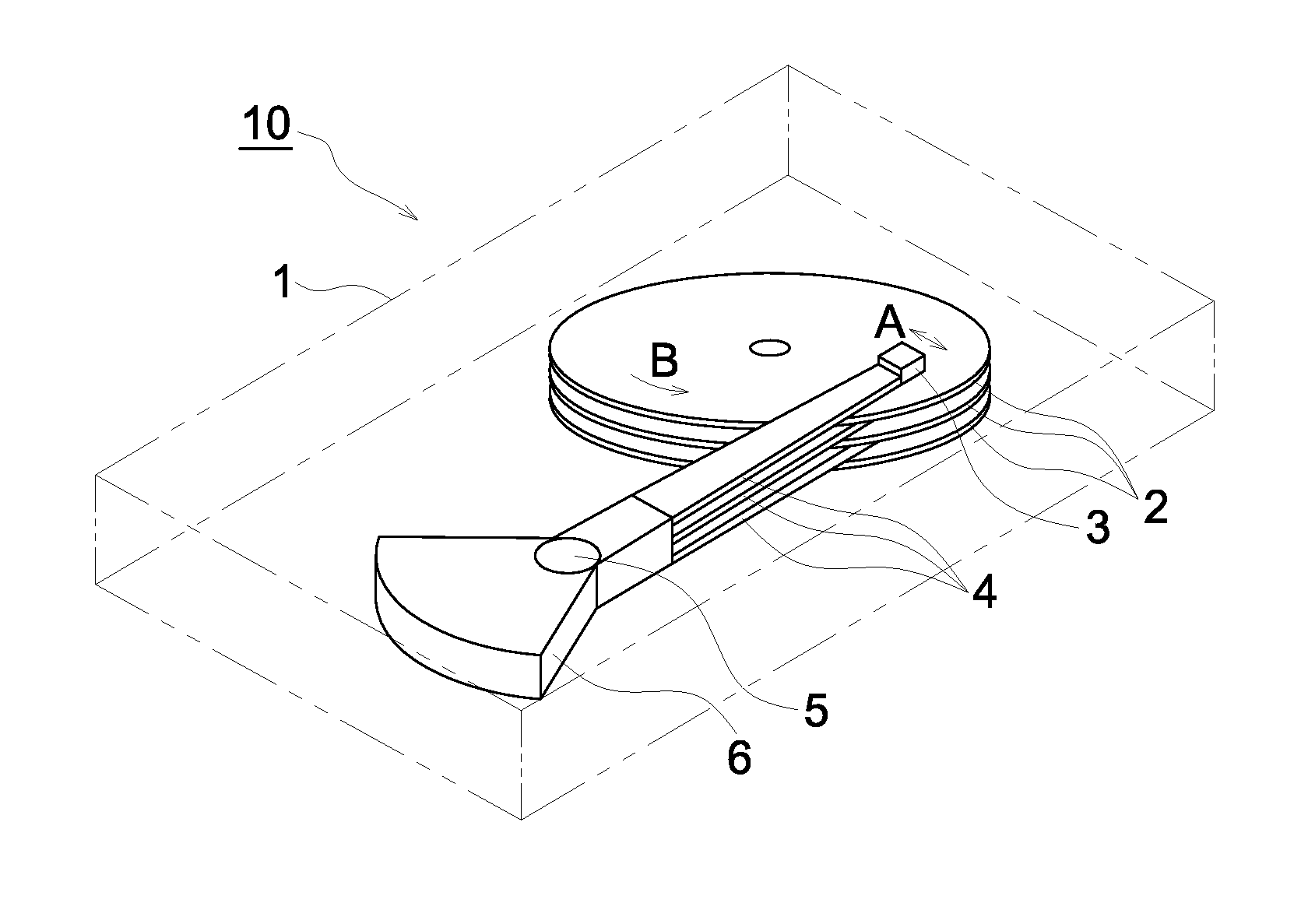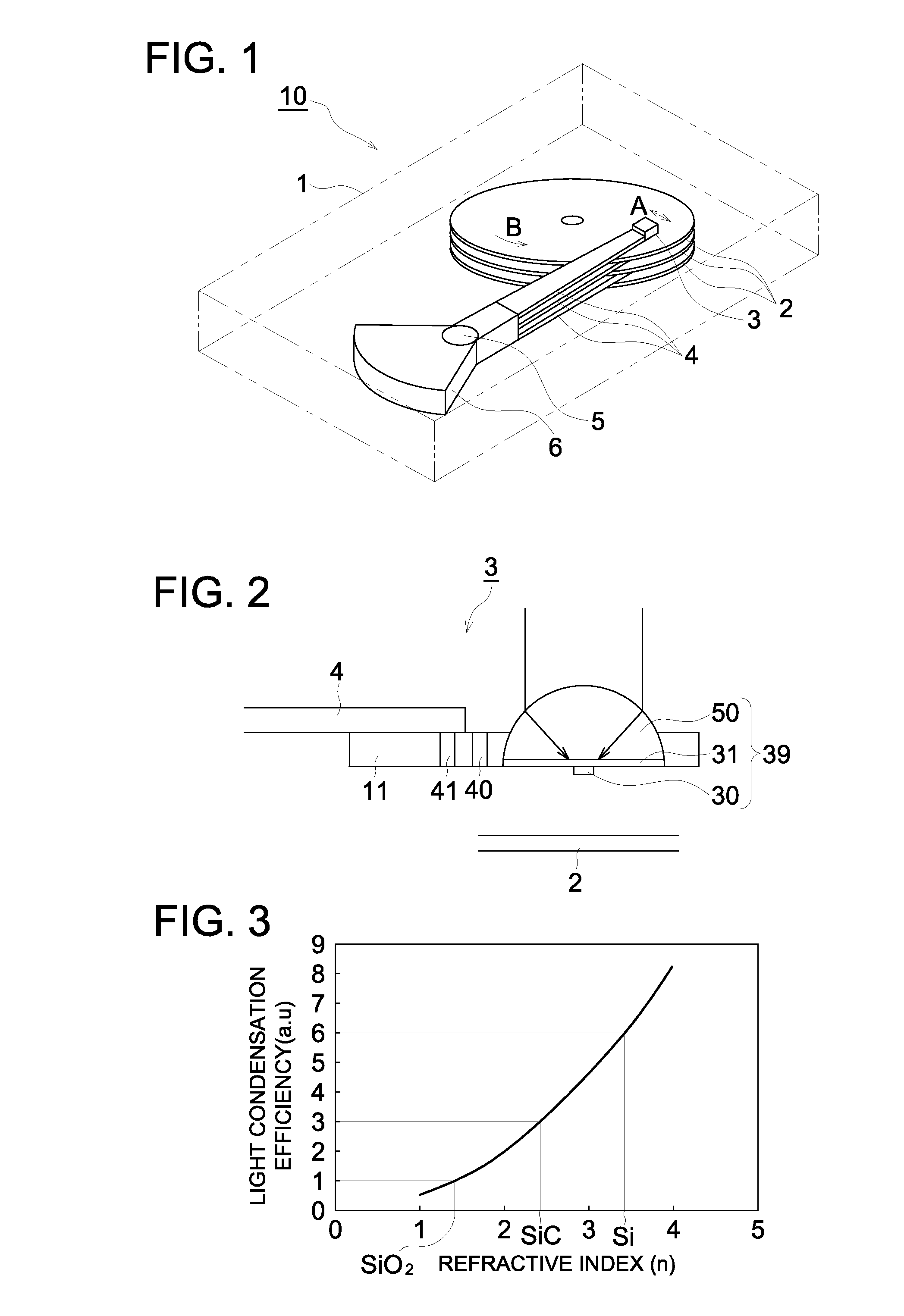Near field light generating device, optically assisted magnetic recording head, optically assisted magnetic recording device, near field optical microscope and near field light exposure apparatus
a technology of optically assisted magnetic recording and recording head, which is applied in the direction of lighting and heating apparatus, applications, instruments, etc., can solve the problems of increasing the magnetic field required for recording, affecting the quality of the material, so as to achieve high efficiency
- Summary
- Abstract
- Description
- Claims
- Application Information
AI Technical Summary
Benefits of technology
Problems solved by technology
Method used
Image
Examples
example 1
[0162]In Example 1, the SILs 50, with the buffer layers 31 of different thicknesses, used in the near field light generating device 39 in the first embodiment shown in FIG. 2 were made. Further, the optically assisted magnetic recording heads 3 of the first embodiment were made each using the above-obtained near field light generating device 39 to verify that a sufficient amount of near field light for magnetic recording was generated.
[0163]The following describes the steps of manufacturing the near field light generating device 39.
[0164]First, eight SILs 50 to be used in the near field light generating devices 39 were made of silicon crystal. Each SIL 50 has a curvature radius of 1.4 mm. Then buffer layers 31 each having a thickness of 50, 100, 250, 500, 1000 or 2000 nm were formed on the plane surfaces of the six SILs 50. The buffer layers 31 were formed on the plane surfaces of the SILs 50 using the CVD (chemical vapor deposition) method using the TEOS (tetraethoxysilane) as mate...
example 2
[0177]In Example 2, the SILs 50 were made of GaAsP and the buffer layer 31 was made of GaF with different thicknesses, by the same process as Example 1. Further, the optically assisted magnetic recording heads 3 of the first embodiment were made each using the above-obtained near field light generating device 39 to verify that a sufficient amount of near field light for magnetic recording was generated.
[0178]The steps of manufacturing the near field light generating device 39 are the same as Example 1, and detailed description will be omitted.
[0179]Similarly to the case of the above-mentioned Example, the buffer layers 31 having thicknesses L of 50, 100, 250, 500, 1000 and 2000 nm were formed on the plane surface of the SILs 50. A gold plasmon probe having a thickness of 40 nm was formed on each buffer layer 31 of the SIL 50 by the same steps as Example 1. As a comparative example, on of the SILs 50 without buffer layers 31, a gold plasmon probe in the same shape was made.
[0180]The ...
example 3
[0192]In Example 3, the SILs 50 of FIG. 9 with the buffer layers 31 formed, by the steam oxidation method, each to have different thickness. Further, the optically assisted magnetic recording heads 3 were made each using the above-obtained near field light generating device 39 to verify that a sufficient amount of near field light for magnetic recording was generated.
[0193]The following describes the steps of manufacturing the near field light generating device 39.
[0194]First, eight SILs 50 to be used in the near field light generating devices 39 were made of silicon crystal. Each SIL 50 has a curvature radius of 1.4 mm. Then buffer layers 31 each having a thickness of 50, 100, 250, 500, 1000 or 2000 nm were formed on the plane surfaces of the six SILs 50. The buffer layers 31 were made by putting the silicon-made SIL 50 in a vapor atmosphere and forming oxide films (SiO2) on the whole surface of each SIL 50.
[0195]A Gold film was formed on each buffer layer 31 of six SILs 50 by the ...
PUM
| Property | Measurement | Unit |
|---|---|---|
| diameter | aaaaa | aaaaa |
| refractive index | aaaaa | aaaaa |
| near field light microscope | aaaaa | aaaaa |
Abstract
Description
Claims
Application Information
 Login to View More
Login to View More - R&D
- Intellectual Property
- Life Sciences
- Materials
- Tech Scout
- Unparalleled Data Quality
- Higher Quality Content
- 60% Fewer Hallucinations
Browse by: Latest US Patents, China's latest patents, Technical Efficacy Thesaurus, Application Domain, Technology Topic, Popular Technical Reports.
© 2025 PatSnap. All rights reserved.Legal|Privacy policy|Modern Slavery Act Transparency Statement|Sitemap|About US| Contact US: help@patsnap.com



